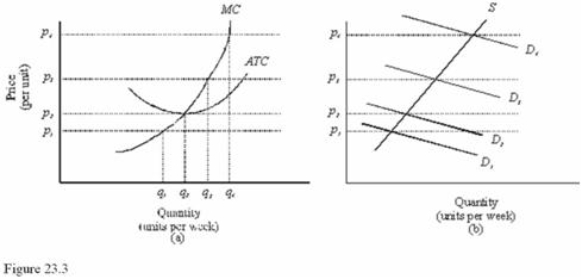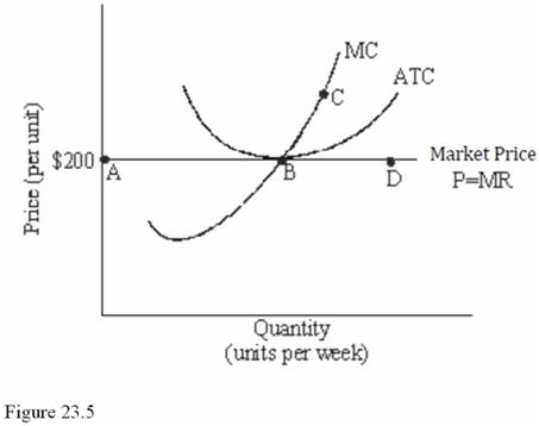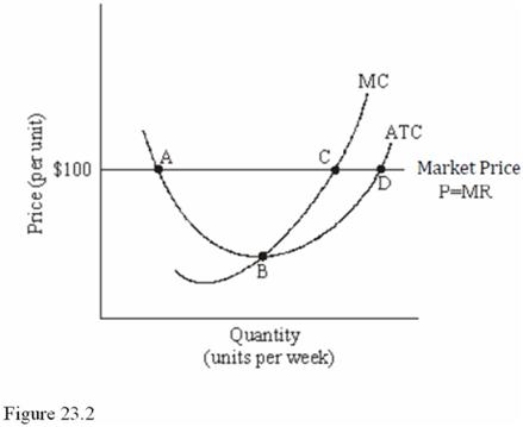A) Price divided by average total cost.
B) Price minus average total cost.
C) Total revenue minus total cost.
D) Total revenue minus variable cost divided by quantity.
Correct Answer

verified
Correct Answer
verified
Multiple Choice
Suppose a perfectly competitive firm is experiencing zero economic profits.In an effort to increase profits, the firm decides to initiate an advertising campaign for its product.The most likely short-run result of this campaign, ceteris paribus, would be
A) Economic losses for the firm.
B) The ability to sell more at the existing market price.
C) The ability to sell more at a lower price.
D) The ability to sell more at a higher price.
Correct Answer

verified
Correct Answer
verified
Multiple Choice
 In Figure 23.3, diagram "a" presents the cost curves that are relevant to a firm's production decision, and diagram "b" shows the market demand and supply curves for the market.Use both diagrams to answer the following question: In Figure 23.3, the price at which a firm makes zero economic profits is
In Figure 23.3, diagram "a" presents the cost curves that are relevant to a firm's production decision, and diagram "b" shows the market demand and supply curves for the market.Use both diagrams to answer the following question: In Figure 23.3, the price at which a firm makes zero economic profits is
A) p1.
B) p2.
C) p3.
D) p4.
Correct Answer

verified
Correct Answer
verified
Multiple Choice
In a competitive market where firms are earning economic profits, which of the following should be expected as the industry moves to long-run equilibrium, ceteris paribus?
A) A higher price and fewer firms.
B) A higher price and more firms.
C) A lower price and fewer firms.
D) A lower price and more firms.
Correct Answer

verified
Correct Answer
verified
True/False
Perfectly competitive firms always earn economic profits in the short run.
Correct Answer

verified
Correct Answer
verified
Multiple Choice
 Refer to Figure 23.2 for a perfectly competitive firm.If this firm produces the level of output corresponding to point C in the short run, it will earn
Refer to Figure 23.2 for a perfectly competitive firm.If this firm produces the level of output corresponding to point C in the short run, it will earn
A) Zero profit.
B) The maximum profit possible.
C) A profit, although not the maximum profit possible.
D) A loss.
Correct Answer

verified
Correct Answer
verified
Multiple Choice
When firms in a competitive market are experiencing zero economic profits, this is an indication that
A) They should be producing a different product.
B) There is currently no better way to use society's scarce resources.
C) They will eventually go bankrupt.
D) Accounting losses are being experienced by these firms.
Correct Answer

verified
Correct Answer
verified
Multiple Choice
If economic profits are earned in a competitive market, then over time
A) Additional firms will enter the market.
B) The market supply curve will shift to the left.
C) Equilibrium price will rise as more firms enter.
D) Normal profit will fall to zero as more firms enter.
Correct Answer

verified
Correct Answer
verified
True/False
Most product markets are perfectly competitive.
Correct Answer

verified
Correct Answer
verified
Multiple Choice
In a perfectly competitive market economy, business failures can benefit society by causing
A) A reallocation of resources to better uses.
B) An increase in market power for the remaining firms.
C) A decline in market prices as remaining firms attempt to increase sales and stay in business.
D) An increase in the number of jobs for bankruptcy lawyers and accountants.
Correct Answer

verified
Correct Answer
verified
Multiple Choice
Which of the following characterizes a firm that is in long-run perfectly competitive equilibrium where profits are maximized?
A) Price equals minimum ATC.
B) Positive economic profit.
C) Price equals marginal cost.
D) Price exceeds marginal cost.
Correct Answer

verified
Correct Answer
verified
Multiple Choice
If a firm decides to make the investment decision to expand its capacity, then it must have discovered that
A) P = ATC.
B) P > AVC.
C) P > ATC.
D) P = AVC.
Correct Answer

verified
Correct Answer
verified
Multiple Choice
 Refer to Figure 23.5 for a perfectly competitive firm.This firm will maximize profits by producing the level of output that corresponds to point
Refer to Figure 23.5 for a perfectly competitive firm.This firm will maximize profits by producing the level of output that corresponds to point
A) A.
B) B.
C) C.
D) D
Correct Answer

verified
Correct Answer
verified
Multiple Choice
If two products are homogeneous, then they
A) Are identical.
B) Differ from each other.
C) Must be used together.
D) Are similar to each other.
Correct Answer

verified
Correct Answer
verified
Multiple Choice
 Refer to Figure 23.2 for a perfectly competitive firm.This firm will maximize profits by producing the level of output that corresponds to point
Refer to Figure 23.2 for a perfectly competitive firm.This firm will maximize profits by producing the level of output that corresponds to point
A) A.
B) B.
C) C.
D) D.
Correct Answer

verified
Correct Answer
verified
Multiple Choice
In which of the following cases would entry and exit cease?
A) P > short-run ATC.
B) P = long-run ATC.
C) P > long-run ATC.
D) P < long-run ATC.
Correct Answer

verified
Correct Answer
verified
Multiple Choice
Which of the following is true about a competitive market supply curve?
A) It is horizontal.
B) It is downward-sloping to the right.
C) It is the sum of the marginal cost curves of all firms.
D) It is vertical.
Correct Answer

verified
Correct Answer
verified
Multiple Choice
If long-run economic losses are being experienced in a competitive market,
A) More firms will enter the market.
B) The market supply curve will shift to the right.
C) Equilibrium price will rise as firms exit.
D) Normal profit will fall to zero as firms enter.
Correct Answer

verified
Correct Answer
verified
Multiple Choice
When an athletic shoe company is producing a level of output at which price is greater than MC, from society's standpoint the company is producing too
A) Much because society is giving up more to produce additional shoes than the shoes are worth.
B) Much because society would be willing to give up more alternative goods in order to get additional shoes.
C) Little because society is giving up more to produce additional shoes than the shoes are worth.
D) Little because society would be willing to give up more alternative goods in order to get additional shoes.High profits in a particular industry indicate that consumers want a different mix of output (more of that particular industry's goods) .
Correct Answer

verified
Correct Answer
verified
Multiple Choice
Which of the following is characteristic of a perfectly competitive market?
A) A small number of firms.
B) Exit of small firms when profits are high for large firms.
C) Zero economic profit in the long run.
D) Marginal revenue lower than price for each firm.
Correct Answer

verified
Correct Answer
verified
Showing 41 - 60 of 151
Related Exams